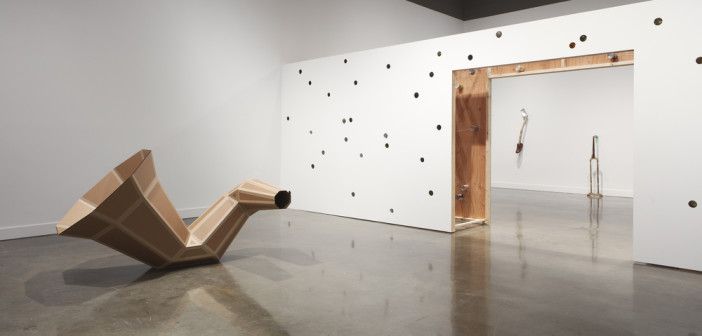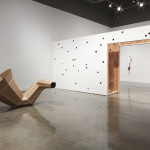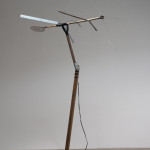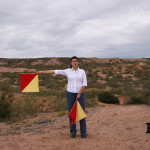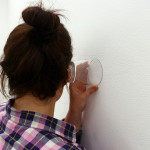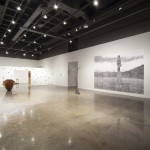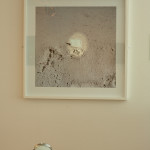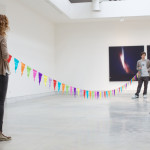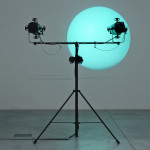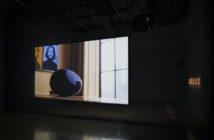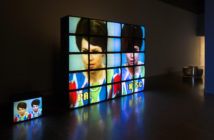João Ribas maintains that Amalia Pica's work should be listened to. Other than the clatter of a slide-tray as it works its way around a carousel, this means listening to silence, more accurately, to the white noise of an exhibition space, which includes the sound of the works themselves, and the sound you the visitor generate. Pica's sculptural objects leave one with the impression that the music has stopped, the party has ended or moved on without us, some of its characteristic (even caricatural) traces existing as proof of our lateness. Strewn confetti appear compacted and pressed into the floor by the weight of a crowd. Tall, swooping, celebratory strands of bulbs come to cluster on the wall in a mass of light, as though half-way through taking them down someone opted to run off with the revelers, leaving the job undone but plugged in. There are other objects that look wanting for interaction with a human body (its voice, its ears, its memory) to give them meaning, yet their function is not entirely clear: how should we use this scrappy antenna propped in a pail? This horn-like cardboard apparatus? A hollow wall riddled with tin-can telephones?
Ribas is right. Were a crowd with all its cacophonous clumsiness to enter the space, the aura that surrounds each of these objects would in all likelihood vanish, their tendency toward simulacra over-emphasized to the detriment of the quiet stories they were designed to contain. Hushed, the environment contributes to a sense of paranoia that is entirely intended—what don't you know about where you are and how you are supposed to behave?
The inner ear comes alive upon reading some of Pica's titles. You discover a playful affinity for the eccentricities of the English language, proper to many bilinguals. Onomatopoeia is a subject in Babble, Blabber, Chatter, Gibber, Jabber, Patter, Prattle, Rattle, Yammer, Yada yada yada, that aforementioned carousel that spins slides of the artist stiffly waving semaphore flags to spell out its own alphabetically ordered title. Catachresis is applied as system to assemble a series of odd object collages, which occupy a space at the rear of the gallery, domesticated by If these walls could talk (with door). Both generate absurd loops of meaning, where the gesture is determined by the language used to define it. They are funny. Self-important in the case of Babble, Blabber…; more endearingly acrobatic in the case of Catachresis. For an artist who confesses to a weakness for linguistic slippages, that's one slippery word. Catachresis stands for things that possess no word to describe them—though it also designates mixed metaphors, paradoxes and contradictions, misapplied words—head of the screw, eye of the needle, teeth of the comb, head of the nail / legs of the table, neck of the bottle, elbow of the pipe, leg of the chair, and so forth. Pica isolates these anthropomorphic peculiarities, then combines them with such formal logic—visual grammar to be exact—that they can stand alone, in proud little formations of meaning waiting to trip you up.
Amalia Pica grew up in Argentina in the 1980s, at the tail-end of years of revolution and dictatorship. This biographical note explains much of the artist's interest in instruments of speech and hearing, and her sympathy for global instances of repressed expression. We are reminded by subtle nods to her girlhood (Pica has made several works about her early education) that her attentiveness to these stories results from her personal experience of national and cultural trauma.
You, the straggler, are offered directives by some of the objects. Eavesdropper, a clear glass affixed to a wall at ear height, invites you to nosiness. Low-tech like the instruments of a childhood prank, the lone glass and the wall of tin-can telephones seem more symbolic than effective in an era where surveillance is seamlessly integrated into our everyday activities. What was cobbled-together, home-made, patched-up, jury-rigged in the first gallery, possesses more theatric polish in the second, where the objects take on the aura of props and backdrops through the use of recognizable stagecraft. Motion-trigged lights ready the set as you enter. These works contain the expectation of performance.
There are a couple of one-liners in the exhibition, nonetheless elegantly constructed. It could be said that I'm a masochist when it comes to ambiguity, but I find pieces like Nostalgia and Moon Golem, while certainly cryptic, fail to surpass the anecdotes that inspired them. Venn diagrams (under the spotlight) veers close to this given its inspiration, but also presents as a study in color and form. The anecdote itself is printed on the wall: "During the period of dictatorship in Argentina in the 1970s ... group theory and Venn diagrams were banned from primary school programs as they could provide a model for subversive thought." In the company of visitors, two complementary spots of colored light periodically combine to make brighter, whiter light, a formal translation of how the overlapping space between two disparate entities can become more powerful (to indulge a pun, enlightened) than the sum of its individual parts.
Pica's quiet subversion of established orders (linguistic, formal, historical) runs throughout the show. Sometimes manifested outright, as in the film On Education, it mostly remains discreet and playful, in a way that reminds us why improvisation and humor can be deemed dangerous by authoritarian regimes. The artist turns things on their ends, adapts materials for unexpected usages, facilitates certain types of behavior through suggestion (gatherings, celebrations, performances), while only seldom demonstrating them herself. The many couples of strangers, meeting to hold a long strand of colorful bunting, might speak to this. Enacting a gesture Pica has orchestrated, the individuals (like two circles) stand temporarily joined by a string. Does their overlap present the opportunity for a new group dynamic, possibly transferred to the space and the people around them? Or are they kept too helplessly distant from one another by the trappings of a forced celebration to communicate effectively? The strength of Amalia Pica's work, that hits you there and then but also resonates for days, comes from her ability to translate manifestations of authority, codified behavior, and stunted communication, from historical totalitarian contexts to the regulated setting of the museum.
- Installation View: Amalia Pica Image courtesy: MIT List Visual Arts Center Photo by Peter Harris Studio
- Amalia Pica, Reconstruction of an Antenna (as seen on TV), 2010 Collection of Nancy and David Frej, Chicago
- Amalia Pica, Babble, Blabber, Chatter, Gibber, Jabber, Patter, Prattle, Rattle, Yammer, Yada yada yada, 2010 Collection of Gregory R. Miller and Michael Wiener, New York
- Amalia Pica, Eavesdropper, 2011 Glass, glue, and performer Dimensions variable Exhibition copy Courtesy the artist and Herald St., London
- Installation View: Amalia Pica Image courtesy: MIT List Visual Arts Center Photo by Peter Harris Studio
- Amalia Pica, Moon Golem, 2009 Zabludowicz Collection, London
- Amalia Pica, On Education, 2008 Courtesy the artist; Galerie Diana Stigter, Amsterdam; Herald St., London; and Marc Foxx Gallery, Los Angeles
- Amalia Pica, Strangers, 2008 Courtesy of the artist
- Amalia Pica, Venn Diagrams (under the spotlight), 2011 Spotlights on tripod, motion sensors, lighting gels, and graphite on wall Installed dimensions variable Colección Patricia Phelps de Cisneros, New York
Amalia Pica is co-organized by the MIT List Visual Arts Center, and the Museum of Contemporary Art Chicago. The exhibition was co-curated by João Ribas, Curator, MIT List Visual Arts Center, and Julie Rodrigues Widholm, Pamela Alper Associate Curator at MCA Chicago.
The exhibition is on view at MIT List Visual Arts Center until April 7, 2013 and will be at the MCA Chicago from April 27—August 11, 2013.

